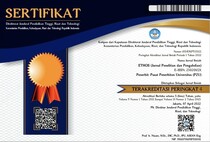Education on the Production of Fig Leaves Extract Hand Sanitizer in Cilayung Village, Jatinangor
DOI:
https://doi.org/10.29313/ethos.v12i1.2582Keywords:
antibacterial, hand sanitizer, simple technology, do-it-yourselfAbstract
Abstract. During the COVID-19 pandemic, people are advised to always wash their hands using soap and running water or hand sanitizer. Concerns about dangerous chemicals in hand sanitizers encouraged us to carry out community service in villages close to our campus, namely Cilayung Village, Jatinangor, West Java. In this activity, we used the fig plant, which was proven to have antibacterial activity. This community service aims to use fig leaf extract as an active ingredient in hand sanitizer. The method used is simple technology on a household scale: boiling fig leaves to obtain an extract, which is then formulated into a hand sanitizer. Before the activity, we optimized the formula of hand sanitizer from fig leaves. During community service, we provide education on fig leaves which have antibacterial activity, accompanied by making your own (do-it-yourself) hand sanitizer that can be used every day. The result, which is assessed through an interactive quiz, shows that education can increase participants’ knowledge regarding the use of fig leaves, and they can process fig leaves into hand sanitizer. The conclusion is that people know the benefits of fig leaves and how to process them into hand sanitizer.
References
Amaranti R, Achiraeniwati E, As’ad N, Nasution A, Sator M. (2016). Pendampingan masyarakat dalam pengolahan sampah organik rumah tangga untuk mendukung program urban farming, Ethos: Jurnal Penelitian dan Pengabdian Masyarakat, 4(2), 283-290. https://doi.org/10.29313/ethos.v0i0.1973
Asadi F, Pourkabir M, Maclaren R, Shahriari A. (2006). Alterations to lipid parameters in response to fig tree (Ficus carica) leaf extract in chicken liver slices. Turkish Journal of Veterinary and Animal Sciences, 30(3), 315-318.
Baedowi FS, Rohim AN, Suhartanti A, Nurrahmah RS, Hidayah VN. (2022) Pelatihan Liquid SoapEducation dalam Upaya Memerangi COVID-19 Menuju Pencegahan Big Cluster di Pondok Pesantren Madania Yogyakarta. Ethos: Jurnal Penelitian dan Pengabdian Masyarakat, 10(2), 260-270. https://doi.org/10.29313/ethos.v10i2.8385
Barolo MI, Mostacero NR, López SN. (2014). Ficus carica L. (Moraceae): an ancient source of food and health. Food Chemistry, 164, 119-127. https://doi.org/10.1016/j.foodchem.2014.04.112
Caliskan O, Polat AA. (2011). Phytochemical and antioxidant properties of selected fig (Ficus carica L.) accessions from the eastern Mediterranean region of Turkey. Scientia Horticulturae, 128(4): 473-478. https://doi.org/10.1016/j.scienta.2011.02.023
De Amorin A, Borba HR, Carauta JPP, Lopes D, Kaplan MA. (1999). Anthelmintic activity of the latex of Ficus species. Journal of Ethnopharmacology, 64(3), 255-258. https://doi.org/10.1016/s0378-8741(98)00139-1
Erez A, Flaishman M, Yablowitz Z. (2003). Breba production under net; effect of training system. Acta Horticulturae, 605, 119-123. https://doi.org/10.17660/ActaHortic.2003.605.18
Flaishman M, Rodov V, Stover E. (2008). The fig: botany, horticulture, and breeding, in: B. Gaaliche (Ed), Horticultural Reviews, 34, 113-197. http://dx.doi.org/10.1002/9780470380147.ch2
Gond NY, Khadabadi SS. (2008). Hepatoprotective activity of Ficus carica leaf extract on rifampicin-induced hepatic damage in rats. Indian Journal of Pharmaceutical Sciences, 70(3), 364-366. https://doi.org/10.4103/0250-474x.43003
https://www.worldweatheronline.com/ciwidey-weather-averages/west-java/id.aspx
Jeong MR, Kim HY, Cha JD. (2009). Antimicrobial activity of methanol extract from Ficus carica leaves against oral bacteria. Journal of Bacteriology and Virology, 39(2), 97-102. http://dx.doi.org/10.4167/jbv.2009.39.2.97
Liu F, Yang Z, Zheng XM, Luo S, Zhang K, Li G. (2011). Nematicidal coumarin from Ficus carica L. Journal of Asia-Pacific Entomology, 14(1): 79-81. https://doi.org/10.1016/j.aspen.2010.10.006
Melgarejo P, Martinez JJ, Hernández F, Salazar DM, Martinez R. (2007). Preliminary results on fig soil-less culture. Scientia Horticulturae, 111(3), 255-259. https://doi.org/10.1016/j.scienta.2006.10.032
Oliveira AP, Valentao P, Pereira JA, Silva BM, Tavares F, Andrade PB. (2009). Ficus carica L.: metabolic and biological screening. Food and Chemical Toxicology, 47(11), 2841-2846. https://doi.org/10.1016/j.fct.2009.09.004
Patil VV, Bhangale SC, Patil VR. (2010). Evaluation of antipyretic potential of Ficus carica leaves. International Journal of Pharmaceutical Sciences Review and Research, 2(2), 48-50.
Perez C, Domınguez E, Ramiro JM, Romero A, Campillo JE, Torres MD. (1998). A study on the glycaemic balance in streptozotocin-diabetic rats treated with an aqueous extract of Ficus carica (fig tree) leaves. Phytotherapy Research, 10(1), 82-83. https://doi.org/10.1002/(SICI)1099-1573(199602)10:1%3C82::AID-PTR776%3E3.0.CO;2-R
Rubnov S, Kashman Y, Rabinowitz R, Schlesinger M, Mechoulam R. (2001). Suppressors of cancer cell proliferation from fig (Ficus carica) resin: isolation and structure elucidation. Journal of Natural Products, 64(7), 993-996. https://doi.org/10.1021/np000592z
Saptarini NM, Pratiwi R, Maisyarah IT. (2022). Colorimetric Method For Total Phenolic And Flavonoid Content Determination Of Fig (Ficus carica L.) Leaves Extract From West Java, Indonesia. Rasayan Journal of Chemistry, 15(1), 600-605. http://dx.doi.org/10.31788/RJC.2022.1516670
Saptarini NM, Mustarichie R, Aulifa DL, Hendriani R, Herawati IE. (2022). Analysis of Antioxidant and Antibacterial Activity of Leaves of Fig (Ficus carica L.) From Ciwidey Distric, West Java, Indonesia. Rasayan Journal of Chemistry, Special Issue, 172-179. http://doi.org/10.31788/RJC.2022.1558205
Sauerbrei A. (2020). Bactericidal and virucidal activity of ethanol and povidone-iodine. Microbiology, 9(9), 1-27. https://doi.org/10.1002%2Fmbo3.1097
Shree MK, Leslie RS, Brundha MP. (2020). Knowledge and awareness on the role of hand sanitizer in prevention of covid 19-a questionnaire Survey. International Journal of Current Research and Review, 12(19), 128-134. http://dx.doi.org/10.31782/IJCRR.2020.SP15
Solomon A, Golubowicz S, Yablowicz Z, Grossman S, Bergman M, Gottlieb HE, Altman A, Kerem Z, Flaishman MA. (2006). Antioxidant activities and anthocyanin content of fresh fruits of common fig (Ficus carica L.). Journal of Agricultural and Food Chemistry, 54(20), 7717-7723. https://doi.org/10.1021/jf060497h
Wijayanto H. Menakar Efektivitas Pembatasan Sosial Berskala Besar Dalam Penanggulangan COVID-19. GEMA PUBLICA : Jurnal Manajemen dan Kebijakan Publik, 2020; 5(2): 98-106.

















